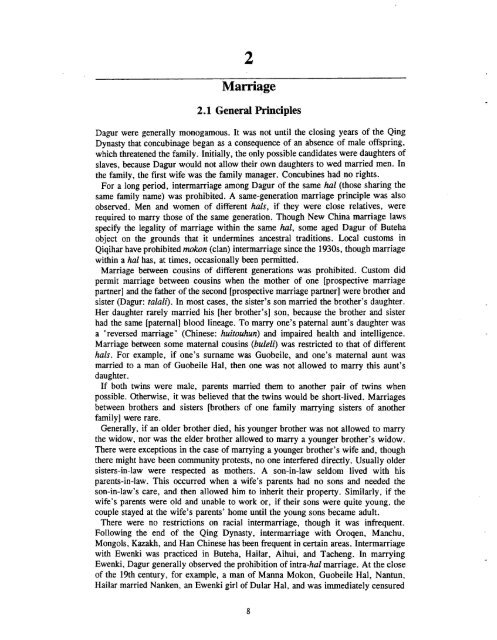China's Dagur Minority - Sino-Platonic Papers
China's Dagur Minority - Sino-Platonic Papers
China's Dagur Minority - Sino-Platonic Papers
You also want an ePaper? Increase the reach of your titles
YUMPU automatically turns print PDFs into web optimized ePapers that Google loves.
Marriage2.1 General Principles<strong>Dagur</strong> were generally monogamous. It was not until the closing years of the QingDynasty that concubinage began as a consequence of an absence of male offspring,which threatened the family. Initially, the only possible candidates were daughters ofslaves, because <strong>Dagur</strong> would not allow their own daughters to wed married men. Inthe family, the first wife was the family manager. Concubines had no rights.For a long period, intermarriage among <strong>Dagur</strong> of the same ha1 (those sharing thesame family name) was prohibited. A same-generation marriage principle was alsoobserved. Men and women of different hals, if they were close relatives, wererequired to marry those of the same generation. Though New China marriage lawsspecify the legality of marriage within the same hal, some aged <strong>Dagur</strong> of Butehaobject on the grounds that it undermines ancestral traditions. Local customs inQiqihar have prohibited mokon (clan) intermarriage since the 1930s, though marriagewithin a hal has, at times, occasionally been permitted.Marriage between cousins of different generations was prohibited. Custom didpermit marriage between cousins when the mother of one [prospective marriagepartner] and the father of the second [prospective marriage partner] were brother andsister (<strong>Dagur</strong>: talalz). In most cases, the sister's son married the brother's daughter.Her daughter rarely married his [her brother's] son, because the brother and sisterhad the same [paternal] blood lineage. To marry one's paternal aunt's daughter wasa "reversed marriage" (Chinese: huitouhrtn) and impaired health and intelligence.Marriage between some maternal cousins (buleli) was restricted to that of differenthals. For example, if one's surname was Guobeile, and one's maternal aunt wasmarried to a man of Guobeile Hal, then one was not allowed to marry this aunt'sdaughter.If both twins were male, parents married them to another pair of twins whenpossible. Otherwise, it was believed that the twins would be short-lived. Marriagesbetween brothers and sisters @rothers of one family marrying sisters of anotherfamily] were rare.Generally, if an older brother died, his younger brother was not allowed to marrythe widow, nor was the elder brother allowed to marry a younger brother's widow.There were exceptions in the case of marrying a younger brother's wife and, thoughthere might have been community protests, no one interfered directly. Usually oldersisters-in-law were respected as mothers. A son-in-law seldom lived with hisparents-in-law. This occurred when a wife's parents had no sons and needed theson-in-law's care, and then allowed him to inherit their property. Similarly, if thewife's parents were old and unable to work or, if their sons were quite young. thecouple stayed at the wife's parents' home until the young sons became adult.There were no restrictions on racial intermarriage, though it was infrequent.Following the end of the Qing Dynasty, intermarriage with Oroqen, Manchu,Mongols, Kazakh, and Han Chinese has been frequent in certain areas. Intermarriagewith Ewenki was practiced in Buteha, Hailar, Aihui, and Tacheng. In marryingEwenki, <strong>Dagur</strong> generally observed the prohibition of intra-hal marriage. At the closeof the 19th century, for example, a man of Manna Mokon, Guobeile Hal, Nantun,Hailar married Nanken, an Ewenki girl of Dular Hal, and was immediately censured
















